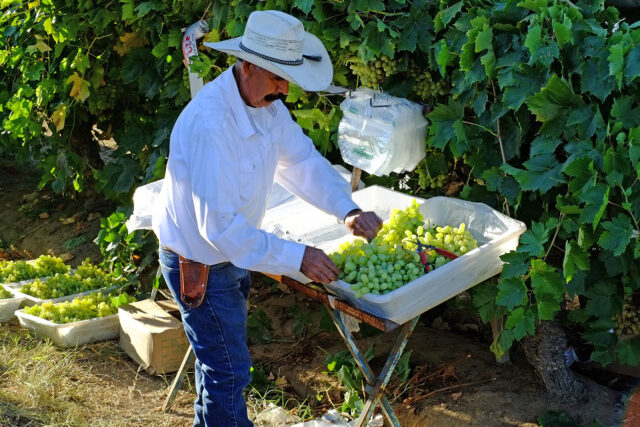Highlights
- Urban water utilities in the San Joaquin Valley rely heavily on groundwater, and many plan to meet the demands of a rapidly growing population with increased pumping.
- These utilities will face unique challenges as the region—which has the state’s largest groundwater deficit—implements the Sustainable Groundwater Management Act (SGMA).
- Smart land use changes will play a critical role in helping communities reduce per-capita water use and recharge more groundwater, a key drought reserve.
- Partnerships between urban utilities, agriculture, local land use authorities, and state agencies can drive resilience efforts and help keep water rates affordable for the region’s residents
San Joaquin Valley communities face unique challenges as the region implements SGMA
The San Joaquin Valley is home to some 4 million residents and growing rapidly—with another 1 million expected by 2040. Groundwater is the primary (and often only) source of water for valley communities. Yet decades of overpumping have stressed the region’s groundwater basins, resulting in land subsidence, dry wells, and falling groundwater reserves.
SGMA requires groundwater users to bring basins into balance by the early 2040s. While investments in new supplies can help close the groundwater deficit, total pumping will also need to decline. Farmers—as the largest groundwater users—will face the greatest adjustments. But the valley’s urban water utilities, which serve most of the population, must also adapt.
Navigating this new reality while meeting the demands of a growing population will be challenging for utilities. However, the valley’s high per-capita water use is declining: it fell during the last drought, and never fully rebounded. And more savings are possible—particularly by reducing landscape water use.
But communities experiencing rising demand will also need new supplies, and most anticipate pumping more groundwater. Smaller urban utilities rely heavily on groundwater, and they face greater challenges in diversifying due to the high costs of accessing surface water. Maintaining reliable and affordable access to water will require comprehensive solutions to manage supplies and demands—and strong partnerships with other water users.
SGMA’s timeline creates uncertainties for urban utilities
SGMA allows local groundwater sustainability agencies (GSAs) 20 years to bring basins into balance. This puts urban communities—which need reliable long-term supplies—at risk:
- If GSAs set a prolonged “glide path” to end overdraft, they may put off hard decisions to manage demand, such as allocating available groundwater. This could lead to costly eleventh-hour fixes.
- Allocating groundwater within basins—and establishing an orderly transition process for ending overdraft—can help water users plan ahead; this will be especially useful for growing communities, which must show they have reliable supplies to authorize new development.
- Groundwater allocations can also facilitate groundwater trading and underground storage—important tools for managing the transition cost-effectively.
- If water users fail to coordinate, this could lead to costly, prolonged litigation.
Resolving these uncertainties sooner, rather than later, will enable robust planning and investment decisions over the long term.
Closer connections between water and land use decisions can build water resilience
Water utilities and local land use authorities are already required to coordinate on the approval of large new developments, but tighter coordination can help ensure water resilience in the SGMA era. Replacing turf and adopting other efficiency measures—in line with the state’s Model Water-Efficient Landscape Ordinance (MWELO)—could help manage demand by reducing outdoor water use in new developments.
On the supply side, utilities, land use authorities, and other GSA members can coordinate to protect areas for groundwater recharge. Many suitable locations are within areas slated for future urban growth; moving fast to identify and protect the best sites—perhaps as multi-benefit “blue belt” lands—should be a priority.
And since residential areas use less water than irrigated farmland, parties should explicitly consider how water-smart urban growth can support farmland transitions under SGMA in ways that benefit local and regional economies.
Partnerships can drive an effective transition to groundwater sustainability for the region’s residents
Partnerships with a variety of other local parties can keep water available and affordable for the valley’s urban residents and support solutions for small communities.
- Managing urban demand. Utilities and land use authorities can team up to promote continued progress on water use efficiency in existing and new development.
- Trading water. Many valley communities have benefited from long-term purchases of water from local agriculture, and this will be continue to be an important pathway to support growth in this highly agricultural region.
- Collaborating on recharge. Utilities, agricultural water districts, and local land use authorities can help shore up supplies through co-investments, including in suitable recharge areas near urban areas.
- Partnering with small communities. About half a million valley residents are served by small water systems or domestic wells, and many face both reliability and quality challenges. Urban utilities can facilitate water system consolidations and provide technical and administrative support; together with agricultural partners, they can also locate recharge projects in areas that improve groundwater supplies for these communities.
State agencies can also be partners in ensuring SGMA’s success. This includes providing support for effective SGMA planning, incentivizing pilot programs for new actions like groundwater allocations and trading, and facilitating and funding drinking water solutions for small communities.
Topics
Drought Floods Health & Safety Net Paying for Water Safe Drinking Water San Joaquin Valley Water Supply Water, Land & Air




